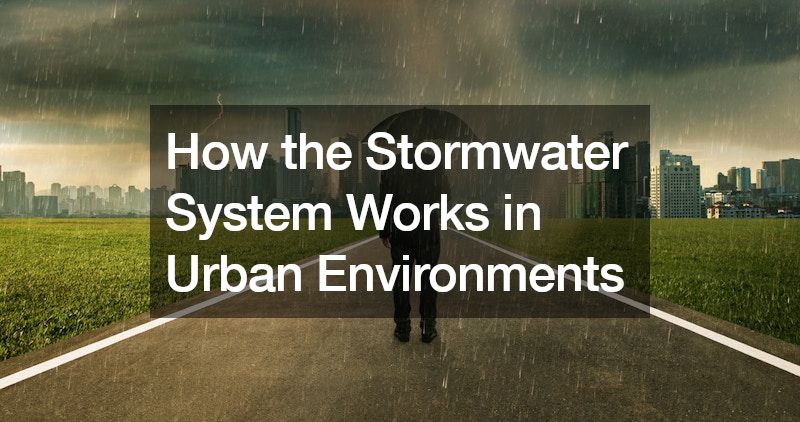In the bustling landscapes of urban environments, where skyscrapers tower and streets teem with activity, managing stormwater becomes a critical challenge. From the moment raindrops touch the pavement to their journey through intricate drainage systems, urban stormwater management plays a vital role in preventing floods, mitigating pollution, and preserving the environment.
The Need for Urban Stormwater Management
Cities are hubs of human activity, characterized by dense populations and extensive infrastructure. While urbanization brings numerous benefits, it also alters the natural landscape, replacing permeable surfaces with impermeable ones such as roads, buildings, and sidewalks.
As a result, rainwater that would have been absorbed into the ground now runs off rapidly, overwhelming drainage systems and leading to a host of problems.
The Basics of Stormwater System
The urban stormwater system comprises a network of infrastructure designed to channel rainwater away from populated areas efficiently. This system includes various components such as gutters, storm drains, pipes, and detention basins, all working together to manage the flow of runoff.
Street Gutters and Sewer Systems
One of the primary paths for stormwater runoff in cities is through street gutters. Streets are intentionally crowned, with sloping surfaces directing water towards the gutters. These gutters, often lined along the curbs, collect the runoff and transport it to storm drains located at intervals along the streets.
In older cities, stormwater and sewage systems were often combined, leading to combined sewer overflows during heavy rainfall events. However, modern urban planning emphasizes the use of separate storm sewer systems, known as municipal separate storm sewer systems (MS4s). These dedicated systems prevent stormwater from mixing with sewage, reducing the risk of pollution in water bodies.
Retention and Detention Ponds
To alleviate the strain on drainage systems and reduce the impact of runoff on downstream areas, cities incorporate retention and detention ponds into their stormwater management strategies. Retention ponds are designed to hold water permanently, allowing it to slowly infiltrate into the ground or evaporate over time. Detention ponds, on the other hand, temporarily store excess runoff during storms, releasing it gradually to prevent flooding.
Challenges and Innovations in Urban Stormwater Management
Despite the effectiveness of conventional stormwater management techniques, challenges persist, particularly in densely developed urban areas. As cities continue to grow, the demand for sustainable solutions to stormwater runoff becomes increasingly urgent.
One innovative approach gaining traction is low-impact development (LID). LID techniques aim to mimic natural hydrological processes by integrating green infrastructure elements like rain gardens, permeable pavement, and vegetated rooftops into urban landscapes. These features help capture and absorb rainwater, reducing runoff volume and improving water quality.
The Future of Urban Stormwater Management
As climate change brings more frequent and intense rainfall events, the importance of effective stormwater management in urban environments cannot be overstated. Cities must continue to invest in resilient infrastructure and sustainable practices to adapt to evolving weather patterns and mitigate the impacts of urbanization on the natural water cycle.
Community Engagement
Community engagement plays a crucial role in urban stormwater management, as it enables municipalities to gain valuable insights, foster public support, and implement effective solutions that address local needs and priorities. By involving residents, businesses, community groups, and other stakeholders in the planning, design, and implementation of stormwater projects, cities can build trust, promote transparency, and enhance the long-term success and sustainability of their initiatives.
One approach to community engagement in stormwater management is through participatory planning processes, which involve stakeholders in decision-making and problem-solving activities. This may include conducting public meetings, workshops, focus groups, and surveys to gather input, share information, and solicit feedback on stormwater issues, concerns, and priorities. By actively involving residents in the planning process, municipalities can ensure that stormwater projects reflect the needs and aspirations of the communities they serve.
In addition to participatory planning, outreach and education are critical components of community engagement in stormwater management. Municipalities can use various communication channels, such as websites, social media, newsletters, and public events, to raise awareness about stormwater issues, explain the importance of sustainable practices, and provide guidance on how residents can contribute to water quality improvement and flood prevention efforts. By empowering residents with knowledge and resources, cities can foster a culture of stewardship and encourage individual and collective action to protect and enhance urban water resources.
Furthermore, community-based monitoring and volunteer programs can actively involve residents in data collection, research, and advocacy related to stormwater management. Citizen science initiatives, water quality monitoring projects, and neighborhood clean-up events provide opportunities for residents to contribute to scientific research, monitor environmental conditions, and participate in hands-on activities that promote environmental stewardship and community cohesion.
Overall, community engagement is essential for building resilient and sustainable stormwater management systems that reflect the values, priorities, and aspirations of the communities they serve. By fostering partnerships, collaboration, and active participation, municipalities can leverage the collective knowledge, expertise, and resources of residents to address stormwater challenges and create healthier, more vibrant, and resilient urban environments.
In conclusion, urban stormwater management is a multifaceted endeavor essential for protecting public safety, preserving the environment, and ensuring the resilience of cities in the face of climate change. By implementing innovative solutions and embracing sustainable practices, urban areas can effectively manage stormwater while fostering vibrant, livable communities for generations to come.
.




